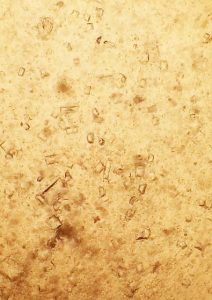Ron Hines DVM PhD
This article is quite similar to another article on struvite urinary tract stones that you can read here.
Reason Why Crystals Might Be Observed Microscopically In Your Dog Or Cat’s Urine
Microscopic crystals in your dog or cat’s urine often mean that the urine voided or otherwise obtained was very concentrated. Urine is often voided when it is supersaturated. That is when it contains dissolved solids in amounts greater than what the surrounding fluid would normally dissolve. Supersaturated urine has a high specific gravity. Whether these dissolved solids begin to crystallize and leave the urine solution to form small crystals depends on the temperature of the urine after it was voided and how long it stands in the veterinarian’s lab before it is examined microscopically. Crystals tend to form as urine cools to room temperature or is placed in a refrigerator. Supersaturated urine relies on various inhibitor and promoter substances present in urine. What those substances are and how they work together is poorly understood. (read here)
When small crystals are associated with urinary tract symptoms, they might be significant. When they are accompanied by struvite or oxalate urinary tract stones (calculi) they always are. Most of these crystals can be identified as to their type by their shape and by the pH (acidity) of the urine in which they were found. As I mentioned, the most common crystals that are associated with urinary tract disease are composed of struvite (magnesium ammonium phosphate aka triple phosphate). At one time, struvite crystals were the most common type associated with feline urological syndrome (FUS) and urinary tract disease in dogs. However, over the last 20 years the number associated with oxalate crystals (calcium oxalate mono or dehydrate) has risen as well. Veterinarians suspect that the current formulations of dog and cat foods and perhaps pet inactivity are responsible for that. However, no hard data exists.
Some genetic metabolic defects can also cause crystals to be present in your pet’s urine – for example, cysteine crystals in male dogs that are genetically predisposed to them or the uric acid crystals common in Dalmatians.
Certain sulfa-containing antibiotics that pet might be prescribed can also account for crystals present in their urine (sulfa and sulfur are not the same thing).
Remember that crystals found in stale urine or previously refrigerated urine may not have formed within your cat or dog. When that is the case, they are just medical artifacts of no significance. Animal hospitals are very busy places. Workloads fluctuate, emergencies divert attention and sometimes too much time passes before the urine sample is examined under a microscope. Crystals observed microscopically in very concentrated first-of-the-morning urine or samples from dehydrated pets may not be a sign of disease nor of crystal formation throughout the day. The presence of other urine abnormalities and your pet’s symptoms should be the decision makers. Stale urine is also likely to contain bacteria that are of little or no significance.
Complementary tests:
Urine pH, Urine bacterial culture and antibiotic sensitivity, Blood calcium level, crystal specimens submitted to laboratory for identification.
DxMe
You are on the Vetspace animal health website
Visiting the products that you see displayed on this website help pay the cost of keeping these articles on the Internet.
